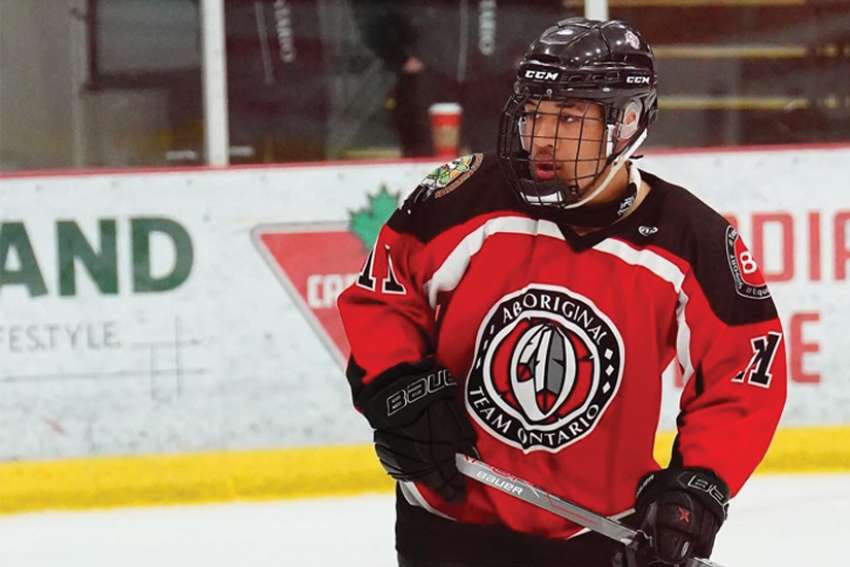As part of a school project, the 17-year-old at Catholic Central High School created the Diversity in Hockey Guidebook to influence professional and minor hockey associations to do all they can to combat racism in the sport. The aim is to help make the game safer and more inclusive for all.
Campbell is scheduled to discuss his work at a Hockey Leadership Conference in London June 17.
“The Hockey Leadership Conference will shed more light on diversity and all the (problematic) stuff that happens in our hockey community and world,” said Campbell, who is half Black and half Indigenous. “We want to educate the older players that went through (the system) already but mostly the young players coming up so they will know how to create a positive environment for the rest of the kids.”
In Campbell’s sports leadership class lead by teacher Wendy Glover, students were asked to create a project on an issue they care about. The theme was making a difference in the sports community. As a hockey player who has experienced racism in the sport, Campbell decided to create the guidebook in hopes that his younger family members wouldn’t have to go through the same struggles he did. The document, he hoped, would educate, explain what goes on, how to help and who athletes can go to if they don’t feel comfortable.
Glover was so impressed by Campbell’s assignment she shared it on social media and tagged Kim Davis, executive vice president of social impact, growth initiatives and legislative affairs with the NHL. Davis saw it and reposted it.
“I couldn’t be more proud of this teen hockey player on his effort to make a difference regarding diversity in hockey and addressing how allies can help,” wrote Glover in a LinkedIn post. “His effort to specifically address steps people can take is exactly the type of work that will influence change by giving people tools to act.”
Discrimination persists at all levels of Canada’s national sport. Following the global reckoning on racism in 2020, hockey organizations were called out for not doing enough to combat the issue. Since then, Hockey Canada introduced an update to its rulebook to focus on recognizing and reporting incidents of maltreatment. Members also approved a new national reporting system for incidents of discriminatory taunts, insults or intimidation, both on the ice and outside of game play.
Campbell’s Indigenous grandfather introduced him to the sport at around age six and Campbell says he immediately was hooked. A centre for the London Junior Knights, Campbell says thankfully he always had positive experiences with his own teammates and coaches. However, against other teams that has not always been the case. He’s experienced a number of challenges and on several incidences been called the N-word. During one game, after informing the referee he was called the N-word, Campbell was told they could do nothing about it. His team brought the situation up to the board and the athlete who used the slur faced punishment.
“Ever since I got a stick in my hand, I just fell in love with the game,” said Campbell. “I faced lots of challenges (with racism) and not really being able to fight back because it would look like a coloured kid lashing out. I always had to keep my composure and not do anything to put a bad rep on my name. There were lots of things I had to overcome to keep myself happy in the game.”
Positivity is the message in his guidebook.
“I wanted (the guidebook) to come off in a positive way (because) people aren’t going to listen if you’re coming across in a negative way. What I mostly wanted to share was my story and some of the things that happened that not everyone knows about. I wanted to shed some light on what we can do to help, and people to contact if something is happening to you. I wanted to shed the most light on how to help if you’re a player, teammate or coach and you see this happening.”
The purpose of this guidebook is to influence professional and minor hockey organizations, players and stakeholders to make sure they are doing all they can to provide a safe and inclusive environment for all players, coaches, officials, families regardless of race, gender or culture, says Campbell. To achieve this, he wants those in the hockey community to use this guidebook as a tool to find resources and to implement training and practices that will further educate coaches, staff, players and others to ensure a safer and more inclusive environment.
“I want BIPOC (Black, Indigenous and other People of Colour) players to be able to play this game comfortably, safely without having to worry about all the outside drama,” said Campbell. “I just want them to be able to play.”


